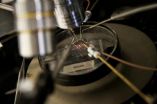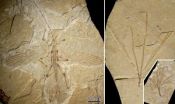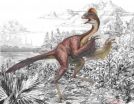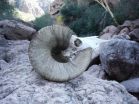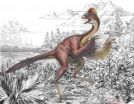(Press-News.org) SALT LAKE CITY, March 20, 2014 – University of Utah electrical engineers fabricated the smallest plasma transistors that can withstand high temperatures and ionizing radiation found in a nuclear reactor. Such transistors someday might enable smartphones that take and collect medical X-rays on a battlefield, and devices to measure air quality in real time.
"These plasma-based electronics can be used to control and guide robots to conduct tasks inside the nuclear reactor," says Massood Tabib-Azar, a professor of electrical and computer engineering. "Microplasma transistors in a circuit can also control nuclear reactors if something goes wrong, and also could work in the event of nuclear attack."
A study of the new transistors by Tabib-Azar and electrical engineering doctoral student Pradeep Pai appears online Thursday, March 20 in the journal IEEE Electron Device Letters, published by the Institute of Electrical and Electronics Engineers. The study was funded by the Defense Advanced Research Projects Agency.
Transistors are the workhorses of the electronics industry. They control how electricity flows in devices and act as a switch or gate for electronic signals. Billions of transistors are typically fabricated as individual but connected components on a single computer chip. The most commonly used type of transistor is called a metal oxide semiconductor field effect transistor, or MOSFET.
Transistors control the flow of electrical charge through a silicon channel using an electric field to turn the transistor on or off, similar to a valve with the electric field as its control knob and electric charge as its current flow. Silicon-based transistors are a crucial component in modern electronics, but they fail above 550 degrees Fahrenheit – the temperature at which nuclear reactors typically operate.
Plasma-based transistors, which use charged gases or plasma to conduct electricity at extremely high temperatures, are employed currently in light sources, medical instruments and certain displays under direct sunlight (but not plasma TVs, which are different). These microscale devices are about 500 microns long, or roughly the width of five human hairs. They operate at more than 300 volts, requiring special high-voltage sources. Standard electrical outlets in the United States operate at 110 volts.
The new devices designed by the University of Utah engineers are the smallest microscale plasma transistors to date. They measure 1 micron to 6 microns in length, or as much as 500 times smaller than current state-of-the-art microplasma devices, and operate at one-sixth the voltage. They also can operate at temperatures up to 1,450 degrees Fahrenheit. Since nuclear radiation ionizes gases into plasma, this extreme environment makes it easier for plasma devices to operate.
"Plasmas are great for extreme environments because they are based on gases such as helium, argon and neon that can withstand high temperatures," says Tabib-Azar. "This transistor has the potential to start a new class of electronic devices that are happy to work in a nuclear environment."
A conventional transistor is made with two active layers, one on top of the other. Electricity flows through one of the layers, called the channel. The other layer, called the gate, controls current flowing in the channel. If sufficient voltage is applied to the gate, the transistor turns on.
For the new study, Tabib-Azar and Pai deposited layers of a metal alloy to form the gate on a 4-inch glass wafer. A layer of silicon then was deposited on top of the gate.
Unlike typical transistors, the Utah microplasma transistor "channel" is an air gap that conducts ions and electrons from the plasma once a voltage is applied. To achieve this unique design, the team etched away portions of the silicon film using a chemically reactive gas. This etching process leaves behind cavities and empty spaces to form the transistor's channel and expose the gate underneath. The channel tested in this new study was 2 microns wide and 10 microns long, and helium was used as the plasma source.
"Although the length scales are much smaller here, we came up with an innovative way to make these structures three-dimensional," Tabib-Azar says. "We are currently connecting these devices to form logic gates and computing circuits that we will test in our experimental nuclear reactor at the University of Utah, a facility not found in most other universities."
Traditional MOSFETs require metal to connect circuits, says Tabib-Azar, but the Utah microplasma devices will use a plasma-based connection to enable communication. As a result, these circuits will only be operational when powered up and will disappear otherwise, making them suitable for defense applications.
These plasma devices could also be used as an X-ray imaging source in the next five years, says Tabib-Azar. Because the device dimensions are so small, X-ray images from a wounded soldier in the field could be collected on a smartphone equipped with transistors that also generate the X-rays, says Tabib-Azar.
In another five years, the devices could be used to detect and identify aerosol pollutants based on the color emitted when the substance passes through the device. "These chemical sensing devices could be used to quantitatively monitor air quality in real time and enable researchers to construct an accurate air-quality map," he adds.
In the nearer-term, these new transistors could be used to generate X-rays to draw fine lines in silicon to pattern microscale devices for the electronics industry. With this new X-ray technique, Tabib-Azar says, "you can do the same thing you would with laser printing, but instead you can use these tiny X-ray sources to print on a silicon wafer. This gives engineers the ability to do X-ray lithography without having to use very heavy lenses and X-ray beam shaping devices."
INFORMATION:
University of Utah College of Engineering
72 S. Central Campus Dr., Room 1650 WEB, Salt Lake City, UT 84112
801-581-6911 fax: 801-581-8692
http://www.coe.utah.edu
Tiny transistors for extreme environs
University of Utah engineers shrink plasma devices to resist radiation
2014-03-20
ELSE PRESS RELEASES FROM THIS DATE:
Where are we with breast cancer in 2013?
2014-03-20
The global burden of breast cancer remains immense in 2013, with over 1.6 million new cases being diagnosed annually. This burden has been increasing at a rate of 3.1% per year, and while the majority of new cases are diagnosed among women in developed countries, the 450,000 deaths per year from the disease are now equally divided between the developing and developed world, the 9th European Breast Cancer conference (EBCC-9) will hear tomorrow (Friday).
Professor Peter Boyle, Director of the University of Strathclyde Institute of Global Public Health at the International ...
Choice of GP practice pilot most popular with young commuters and patients moving home
2014-03-20
A pilot scheme allowing patients to visit GPs outside the area they live in was most popular among younger commuters and people who had moved house but did not want to change their GP, according to a new report by the London School of Hygiene & Tropical Medicine.
The Department of Health's Choice of GP pilot scheme found that while demand overall was modest, participants were generally positive about the scheme and there was little sign of major increased cost to primary care trusts (PCTs) for providing the service. Patients will be able to register with volunteer practices ...
Future heat waves pose threat to global food supply
2014-03-20
Heat waves could significantly reduce crop yields and threaten global food supply if climate change is not tackled and reversed.
This is according to a new study led by researchers at the University of East Anglia and published today, 20 March, in IOP Publishing's journal Environmental Research Letters, which has, for the first time, estimated the global effects of extreme temperatures and elevated levels of carbon dioxide (CO2) on the production of maize, wheat and soybean.
Earlier studies have found that climate change is projected to reduce maize yields globally ...
Data on antibiotic use in non-EU countries should stimulate development of action plans
2014-03-20
A new study, published in The Lancet Infectious Diseases journal, provides the first ever reliable data on antibiotic use in non-European Union (EU) southern and eastern European countries and newly independent states.
The research, which was led by Dr Herman Goossens, of the Vaccine and Infectious Disease Institute (VAXINFECTIO) at the University of Antwerp, Belgium, is a critical first step in identifying targets for improvements in the way antibiotics are used in these countries. The authors hope that the findings will aid the development of national action plans ...
Fossils of earliest stick insect to mimic plants discovered
2014-03-19
An ancient stick insect species may have mimicked plant leaves for defense, according to a paper published in the open-access journal PLOS ONE on March 19, 2014 by Maomin Wang, from Capital Normal University, China and colleagues.
Many insects have developed defense mechanisms, including the ability to mimic the surrounding environment. Stick and leaf insects mimic plants from their environment, but scientists know little about the original of this interaction due to little or no previous stick insect fossil records showing this adaptation. The scientists discovered three ...
Large feathered dinosaur species discovered in North America
2014-03-19
Fossils found in western North America reveal a new species of large-bodied, feathered oviraptorosaurian theropod dinosaur from the latest Cretaceous Period, according to a paper published in the open-access journal PLOS ONE on March 19, 2014 by Matthew Lamanna from Carnegie Museum of Natural History in Pennsylvania and colleagues.
Known for their beaks, long necks, and relatively short tails, the bird-like oviraptorosaurian group contains dinosaurs with body sizes ranging from a few kilograms to more than one metric ton. The scientists described three well-preserved partial ...
Fossilized bighorn sheep poop reveals early Holocene population
2014-03-19
Genetic analysis of ancient poop found off the coast of Mexico suggests bighorn sheep may be native to the island, according to a paper published in the open-access journal PLOS ONE on March 19, 2014 by Benjamin Wilder from University of California Riverside and colleagues.
Bighorn sheep were not thought to inhabit Tiburón Island, the largest island in the Gulf of California and Mexico, prior to their introduction in 1975. Scientists discovered fossilized dung in the mountains of Tiburón Island that challenges that assumption. Scientists compared the pellet-shaped poop ...
Bighorn sheep went extinct on desert island in Gulf of California, study finds
2014-03-19
RIVERSIDE, Calif. — Using ancient DNA analysis and other techniques, a research team led by conservation biologists at the University of California, Riverside has determined that bighorn sheep, so named for their massive spiral horns, became extinct on Tiburón Island, a large and mostly uninhabited island just off Sonora, Mexico, in the Gulf of California, sometime in the last millennium — specifically between the 6th and 19th centuries.
The result, published March 19 in PLOS ONE, is a surprise because conventional wisdom among wildlife biologists and the indigenous Seri ...
A 'chicken from hell' dinosaur
2014-03-19
SALT LAKE CITY, March 19, 2014 – Scientists from Carnegie and Smithsonian museums and the University of Utah today unveiled the discovery, naming and description of a sharp-clawed, 500-pound, bird-like dinosaur that roamed the Dakotas with T. rex 66 million years ago and looked like an 11 ½-foot-long "chicken from hell."
"It was a giant raptor, but with a chicken-like head and presumably feathers. The animal stood about 10 feet tall, so it would be scary as well as absurd to encounter," says University of Utah biology postdoctoral fellow Emma Schachner, a co-author of ...
Smithsonian collaborates with paleontologist team to reveal new large, feathered dinosaur
2014-03-19
A team of scientists from the Smithsonian's National Museum of Natural History, the Carnegie Museum of Natural History and the University of Utah has described an unusual bird-like dinosaur previously unknown to science, resembling a cross between a modern emu and a reptile. The new species, Anzu wyliei, lived 68 to 66 million years ago and was identified from three partial skeletons collected from the Upper Cretaceous Hell Creek Formation in North and South Dakota. The species belongs to Oviraptorosauria, a group of dinosaurs mostly known from fossils found in Central ...
LAST 30 PRESS RELEASES:
Sports injuries sustained during your period might be more severe
World's first successful 2 Tbit/s free-space optical communication using small optical terminals mountable on satellites and HAPS
Can intimate relationships affect your heart? New study says ‘yes’
Scalable and healable gradient textiles for multi‑scenario radiative cooling via bicomponent blow spinning
Research shows informed traders never let a good climate crisis go to waste
Intelligent XGBoost framework enhances asphalt pavement skid resistance assessment
Dual-function biomaterials for postoperative osteosarcoma: Tumor suppression and bone regeneration
New framework reveals where transport emissions concentrate in Singapore
NTP-enhanced lattice oxygen activation in Ce-Co catalysts for low-temperature soot combustion
Synergistic interface engineering in Cu-Zn-Ce catalysts for efficient CO2 hydrogenation to methanol
COVID-19 leaves a lasting mark on the human brain
Scientists use ultrasound to soften and treat cancer tumors without damaging healthy tissue
Community swimming program for Black youth boosts skills, sense of belonging, study finds
Specific depressive symptoms in midlife linked to increased dementia risk
An ‘illuminating’ design sheds light on cholesterol
Who is more likely to get long COVID?
Study showcases resilience and rapid growth of “living rocks”
Naval Research Lab diver earns Office of Naval Research 2025 Sailor of the Year
New Mayo-led study establishes practical definition for rapidly progressive dementia
Fossil fuel industry’s “climate false solutions” reinforce its power and aggravate environmental injustice
Researchers reveal bias in a widely used measure of algorithm performance
Alcohol causes cancer. A study from IOCB Prague confirms damage to DNA and shows how cells defend against it
Hidden viruses in wastewater treatment may shape public health risks, study finds
Unlock the power of nature: how biomass can transform climate mitigation
Biochar reshapes hidden soil microbes that capture carbon dioxide in farmland
Reducing saturated fat intake shows mortality benefit, but only in high-risk individuals
Manta rays create mobile ecosystems, study finds
Study: Mixed results in using lipoic acid to treat progressive multiple sclerosis
Norbert Holtkamp appointed director of Fermi National Accelerator Laboratory
New agentic AI platform accelerates advanced optics design
[Press-News.org] Tiny transistors for extreme environsUniversity of Utah engineers shrink plasma devices to resist radiation

